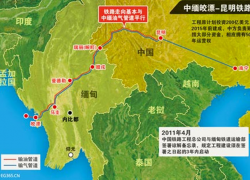
The Chinese ambassador to Burma, also known as Myanmar, has denied published reports that indicate a planned railway line from Kunming to Kyaukpyu in the Arakan State, Burma has been abandoned. According to Xinhua, the Chinese state-run news agency, Ambassador Yang Houlan has denied the abandonment of the project by China. He made the statement when asked at a press conference in Yangon about the project.
According to the news agency, a Burma economic official who declined to be identified confirmed to the agency that the Kyaukpyu-Kunming railway has not been cancelled. The unnamed official said that the project “needs time to continue coordination”, according to the report.
The news service Deutsche Presse-Agentur (DPA) ran an article on July 22 that indicated the project had been cancelled and quoted an unnamed source who was reported to be a senior official in the Burmese government who said the project would not move forward.
According to the report, the Memorandum of Understanding between the two nations has expired and there has been no effort on the part of Chinese officials to enter into a new agreement.
The unnamed official is reported to have gone on to say that the project was being abandoned because of “people’s desires” and the view by many that the project has a greater number of disadvantages than advantages. Some have protested in the streets regarding potential damage to socially and historically significant sites by the proposed railway route.
DPA indicates that neither government has moved forward with the rail line supposed to run 1,215 kilometers since the two governments entered into an agreement in regarding the project in April 2011. The rail was intended to go from Yunnan to the Arakan State’s Kyaukpyu seaport along the same route as the oil and gas pipelines recently built by a firm owned by the Chinese government.


One Response to “China Says It Has Not Abandoned the Kunming-Kyaukpyu Railway”
Trackbacks/Pingbacks
[…] city of 6.5 million central to China’s ‘rejuvenate the Southwest’ development strategy. Plans exist to supplement these hard infrastructural links with a railway connection running parallel to the […]